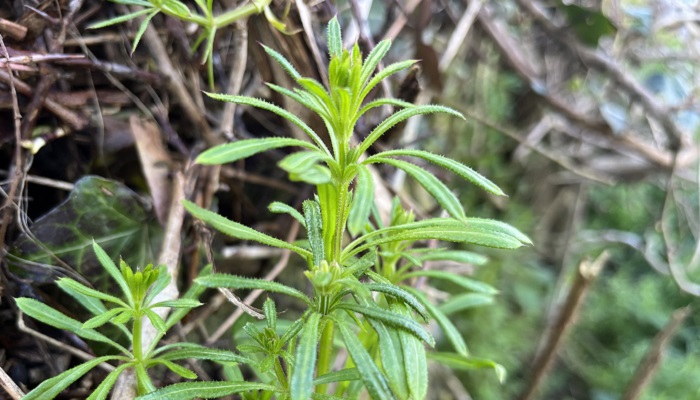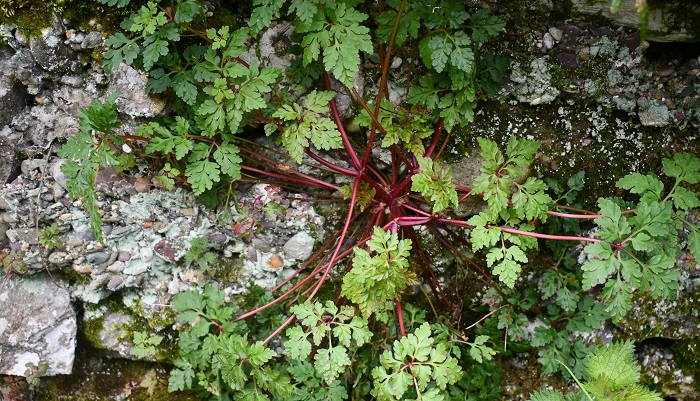21 April 2024
Growing Wild – Cleavers and Herb Robert

Catherine Keena, Teagasc Countryside Management Specialist, takes a closer look at some of our native Irish biodiversity, focusing on cleavers and herd robert.
Cleavers
Look out for cleavers (pictured above) or sticky-backs or robin run the hedge. They are annuals, with plants sprouting from seeds each year. Tall, straggly, sticky, square stems carry whorls of leaves with tiny hooks, allowing plants clamber through vegetation to reach light. Clusters of tiny, starry, white four-petalled flowers develop into furry green spheres with velcro-like hooks, which cleave or stick to passing animals aiding seed dispersal. Grassy margins in tillage fields reduce the spread of cleavers into crops.
Called goose-grass as it was fed to geese and sop an tséaláin or wispy strainer, as it may have been used to sieve hairs out of milk – cleavers is part of our native Irish biodiversity.
Herb robert
Look out for herb robert (pictured below), sometimes easily identified by its red stems. In exposed situations, especially where water is scarce, the stems and leaves become bright red. The stems have prominent joints where they branch. Herb robert was valued in folk medicine to stop bleeding and used to cure redwater in cattle.

Triangular leaves are divided into lobes – five in upper leaves and three in lower leaves – and each lobe is further lobed or toothed.
Delicate pink flowers bloom from April to November. Five unnotched petals have lighter pink lines running into the centre of the flower where orange anthers protrude. Herb Robert is part of our native Irish biodiversity.
Previous Growing Wild articles
- Growing Wild – Tutsan and Woodrushes
- Growing Wild – Shamrock and Primrose
- Growing Wild – Blackthorn flowers and whitethorn leaves
- Growing Wild – haws and spindle fruit
- Growing Wild – Crab Apples and Elderberries
- Growing Wild – Ivy flowers and Common knapweed
- Growing Wild – Meadowsweet, Ox-eye Daisy and Selfheal
- Growing Wild – Marsh marigold and Ribwort plantain
- Growing Wild – Dandelions and cowslips
- Growing Wild – Lesser Celandine and Ivy berries
- Growing Wild – Winter Heliotrope and frogspawn
- Growing Wild – Willow Catkins and Birds Nests
- Growing Wild – Harts Tongue and Hazel
- Growing Wild – Holly Berries and Scot’s Pine
- Growing Wild – Whins and Ferns
- Growing Wild – Rose Hips and Flowering Ivy
- Growing Wild – Yarrow and Herb Robert
- Growing Wild – Elderberries and Blackberries
- Growing Wild – Haws and Spindle
- Growing wild – Guelder Rose and Sloes
- Growing wild – Purple loosestrife and Lord and Ladies
- Growing Wild – willowherb and water mint
- Growing Wild – dandelion and greater stitchwort
- Growing Wild – willow, primrose and lady’s smock
- Growing Wild – whitethorn and cow parsley
- Growing Wild – bluebells and guelder rose
- Growing wild – Honeysuckle and Foxglove
- Growing Wild – Elder and Ragged Robin
- Growing wild – dog rose and meadowsweet
- Growing wild – Privet and Lady’s Bedstraw
- Growing Wild – Bird’s foot trefoil and Knapweed
